An Expanding Role: The Use of Ultrahigh Performance LC–TOF-MS, GC–TOF-MS, Accurate Mass, and Isotope Modeling for Screening Complex Mixtures
Special Issues
Ultrahigh performance liquid chromatography (LC)–time-of-flight mass spectrometry –(TOF-MS) and gas chromatography (GC)–TOF-MS are powerful approaches for screening target compounds and identifying or characterizing nontarget compounds in complex mixtures. The combination of accurate mass data and newly developed software enables truly generic screening methods with TOF-MS, and the confident detection, identification, and confirmation of small molecules in a range of application areas.
There are known knowns. These are things we know that we know. There are known unknowns. That is to say, there are things that we know we don't know. But there are also unknown unknowns. There are things we don't know we don't know. —Donald Rumsfeld (US Secretary of Defense)
Traditionally, screening of targeted compounds in complex matrices involved the use of chromatographic techniques such as liquid chromatography (LC) and gas chromatography (GC) with detectors such as UV or flame-ionization detection (FID), which gave little selectivity. The sensitivity and selectivity of the analytical methods relied upon extensive sample extraction and cleanup procedures. Many laboratories have adopted the use of more selective detectors such as fluorescence for LC or electron capture, or nitrogen–phosphorus detectors in GC; however, methods using these approaches tend to be compound class specific and remained critically dependent upon sample preparation. The desire to analyze different compound classes and to reduce sample preparation has led many laboratories to use mass spectrometry (MS) for screening complex matrices. GC–MS and LC–MS can reduce the need for time-consuming sample preparation procedures and support the development of more generic extraction procedures that are a prerequisite for comprehensive multiresidue analysis.
Selected ion recording (SIR) and multiple reaction monitoring (MRM) are common nominal mass (± 1 Da) MS and MS-MS methods that enable targeted screening of a finite number of compounds to be achieved (for example, in metabolite–impurity profiling and screening for pesticide residues or veterinary drug residues in food). While ideal for detection and quantitation, these approaches are impractical for comprehensive, generic screening and particularly for the identification of unknown or unexpected compounds. In contrast, time-of-flight (TOF) MS provides the ideal combination of speed, sensitivity, and selectivity. TOF-MS has the full-spectrum sensitivity and the spectral acquisition speed to take full advantage of the narrow peak widths from GC and ultrahigh performance LC. Another key advantage of orthogonal acceleration (oa) TOF-MS is in its ability to provide routine accurate mass measurement (typically <5 ppm root mean square). The importance of accurate mass measurement for the confident detection and identification of compounds from these data cannot be understated. Accurate mass provides the high level of specificity required for the component detection in the presence of multiple coeluted species and enables determination of elemental composition and can help structural elucidation of nontarget compounds. Recent advancements in software technology that utilize novel isotope modeling, results filtering, and accurate mass library searching routines have also made it possible to significantly simplify compound detection, identification, and confirmation from accurate mass data.
Here we describe the feasibility of truly generic accurate mass ultrahigh performance LC–TOF-MS and GC–TOF-MS methods for the analysis of potentially unlimited numbers of compounds with minimal sample preparation. Results from the screening of veterinary drug residues and pesticides in food demonstrate the ability of this technology to screen for targeted compounds and to detect and aid the identification of unknown or unexpected components from complex matrices.
Multiresidue Analysis of Pesticides in Food by GC–TOF-MS
The inappropriate or unlawful use of pesticides on agricultural produce can result in unacceptably high levels of residues in produce destined for human consumption. Produce that enters the food distribution chain that is to be used for this purpose must contain less than the statutory maximum residue limit (MRL) of any given residue. In the European Union, legislation sets and controls MRLs in food and feeding stuffs (1). One key feature of the recent legislation is that a default MRL of 0.01 mg/kg will apply to those commodities when no specific MRL is set. Given that there are over 800 compounds in use to control pests, it is more efficient to extract and determine as many of them as possible during a single analysis.
To establish a suitable screening technique, a number of requirements must be met to effectively extract, separate, detect, and identify all components. These include minimal nonselective sample preparation for a wide range of compound groups with different polarities; simple high-resolution GC separation to minimize matrix interference while maintaining resolution of critical pairs; and automated peak detection and deconvolution of all components in the sample.
Generic extraction procedures have been reported for the analysis of a wide range of pesticides in fruits and vegetables (2) and fatty samples (3) typically using acetonitrile followed by dispersive solid-phase extraction (SPE) cleanup.
We employed a GC–TOF-MS method for the targeted screening of pesticide residues in various food commodities at the legislated concentration of 0.01 mg/kg. The method is extended to include nontarget screening results using automatic peak detection, deconvolution, and library searching with accurate mass confirmation. The sample extraction, GC, and TOF-MS methods have been described previously (4). We used an oa-TOF instrument (GCT Premier, Waters Corporation) with electron ionization mode and spectra were obtained over the mass range 50–500 Da. We operated the instrument at over 7000 resolution (fwhm), and the instrument generated accurate mass spectra using a reference compound of known mass, which was introduced to the instrument throughout the analysis.
Targeted Screening
Initially, four food commodities (cucumber, sweet pepper, grapefruit, and wheat flour) were screened for known pesticides to validate the approach. 0.01 mg/kg was chosen to be the reporting level because this is the target MRL for active substances in products for which no specific MRL is set (5).
To illustrate the improvement in selectivity offered by accurate mass chromatograms, vinclozolin (0.01 mg/kg) was analyzed in cucumber, a relatively simple matrix. The extracted ion chromatogram at m/z 212 in Figure 1(generated with a 1 Da window, as it is typically done when using a quadrupole or ion trap–type mass spectrometer) contains a number of intense peaks that could lead to interference when using automatic integration. In the accurate mass chromatogram (20 mDa, m/z 212.0034), vinclozolin has little or no interference, improving the selectivity of the method.
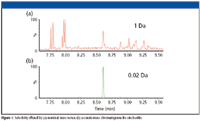
Figure 1
Improving the selectivity can lead to an increase in the signal-to-noise ratio (S/N), which can make the difference between detecting the compound and not detecting it (Figure 2). The nominal mass chromatogram (1 Da, m/z 248) results in an S/N of 4:1. In the accurate mass chromatogram (20 mDa, m/z 248.0397) the S/N has increased to 49:1. The mean difference between the nominal and accurate mass S/N was a factor of five for all residues.
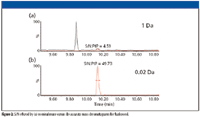
Figure 2
To test the quantitative capabilities of this approach, 30 standard compounds were prepared in the concentration range 5–500 pg/μL (equivalent to 0.005–0.5 mg/kg with PCB 138 used as an internal standard) and spiked into each matrix. The data from the subsequent GC–TOF-MS analysis were processed automatically using a dedicated software package for detection and quantification of target compounds (TargetLynx, Waters Corporation). In Figure 3, the quantitative results for one of the compounds in grapefruit, pirimiphos-methyl (at a spiked concentration of 0.01 mg/kg), are shown. All 30 residues could be screened using this method in all matrices to a concentration of 0.01 mg/kg, demonstrating the applicability of GC–TOF-MS in targeted screening and quantitation.
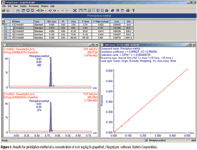
Figure 3
Five matrices were used to further test the method — orange, cherry tomato, grapes, kiwi, and strawberry (a cucumber matrix–matched calibration curve was used for quantification purposes). Automatic quantification was carried out, with two accurate mass chromatograms (0.02 Da) processed for each residue. Figure 4 shows the quantification (0.067 mg/kg) of chlorpyrifos in grapes. This correlates well with a targeted tandem quadrupole MS-MS method (Quattro micro GC, Waters Corporation), in which the concentration was found to be 0.066 mg/kg (6).

Figure 4
Untargeted Screening
In an untargeted screening environment, TOF-MS generates an information-rich data set requiring considerable analysis to detect, deconvolute, and identify the compounds present, which is very time-consuming if performed manually. We chose to process the data using software (ChromaLynx, Waters Corporation) that automatically plots the reconstructed ion chromatograms (RICs) of up to eight most intense ions at any point in the chromatogram. If a peak is found to satisfy a set of user-defined parameters, then the software will record this as a component peak and generate its deconvoluted mass spectrum. The spectrum can then be submitted to an automatic library search routine with the ability to test the confidence of library hits using accurate mass scoring.
Processing of the 0.05-mg/kg spiked cucumber extract located 550 total components in the chromatogram, including 30 spiked residues. Etrimfos is an example of one of the untargeted compounds that we found (Figure 5), which was confirmed with three individual ions (within 1.1 mDa of their expected accurate mass). More than 90% of the spiked residues at 0.05 mg/kg were located and identified using this method, further demonstrating the applicability of GC–TOF-MS in nontarget screening.
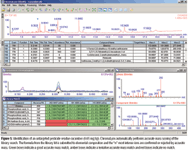
Figure 5
Multiresidue Analysis of Veterinary Drug Residues by Ultrahigh Performance LC–TOF-MS
A wide variety of veterinary drugs are used as antibiotics in livestock around the world. In many countries, including EU member states and the United States, testing for these compounds in animal-based food products is mandatory and the permissible concentration levels are strictly regulated. Due to the complexity of matrices (for example, muscle tissue, urine, and milk) and the large number of potential analytes, it is beneficial to use a generic analytical method applicable to a diverse range of samples, which means data can be reprocessed to search for new compounds if "food scares" arise.
Traditional methods for analyzing veterinary drugs in biological matrices include microbiological or immunochemical techniques. While they are rapid and cost-effective, they are only suitable for one analyte or class, and have limited quantitative capability. High performance LC with UV or fluorescence detection is commonly used for quantification and confirmation; however, extensive sample cleanup is needed to achieve the required sensitivity and selectivity of analysis.
Here we demonstrate the feasibility of a truly generic LC–MS method for the untargeted analysis of potentially unlimited numbers of residues with minimal sample preparation. Milk samples were spiked with standard solutions containing 41 compounds from five classes (tetracyclins, sulfonamides, quinolones, macrolides, and benzimidazoles) at concentrations of 0.5, 1, 2, 5, 10, 25, 50, and 100 μg/L, respectively. These concentrations cover the relevant concentration range with respect to the MRL of the analytes. The experimental setup has been described previously (5), in which an ACQUITY UPLC System (Waters Corporation) was used with columns containing 1.7-μm size novel packing material and operated at high pressure to obtain maximum speed and chromatographic resolution. An oa-TOF-MS system (LCT Premier XE, Waters Corporation) was used with electrospray ionization (in positive ion mode) to acquire data over the mass range 100–1000 Da at high resolution (>10,000 fwhm). An independent reference compound was used over the duration of the analysis to enable generation of accurate mass data (<3 ppm).
Initial manual interrogation of the data was performed to determine the sensitivity on spiked compounds in milk, and to investigate the quantitative capability of the ultrahigh performance LC-TOF system. Figure 6 shows that good linearity was observed and that the limit of detection/limit of quantitation (LoD/LoQ) is much lower than the MRL concentration.
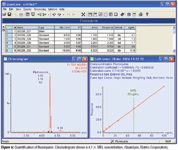
Figure 6
The Use of Isotope Ratio Models for Screening
Elucidation of structure for nontarget compounds using accurate mass requires the calculation of candidate elemental compositions. This type of analysis rarely results in a single candidate formula, and it is not unusual to have thousands of candidate formulas, even with high mass accuracy. As such, it is problematic to decipher which is the correct formula, so we employ i-FIT software (an accurate mass and isotope ratio correlation tool) to aid this process. The i-FIT software (Waters Corporation) is a two-stage process in which a mass spectral correlation algorithm orders the list of candidate formula by (i-FIT) score, followed by element prediction filters that remove formulas that are considered "incorrect" based on interpretation of the spectral data. The outcome is a "focused list" of potential candidate formulas. The element prediction filters have the potential to remove greater than 99% of the "incorrect" candidate formulas (7).
Screening of compounds in this veterinary drug residue analysis study is carried out by a comparison of the experimental data to a potentially limitless library of experimental and theoretical spectra with accurate mass scoring providing increased confidence in compound library hits. A spectral library of standard solutions was acquired with retention time data (oa-TOF aperture voltage of 8 V), including spectra from collision-induced dissociation (CID) (aperture voltage of 30 V), which contained fragment ions to assist in compound characterization. These spectra were all quality checked by isotope interrogation software (i-FIT, Waters Corporation) (7). A library was created containing a normal MS spectrum and at least one fragmented spectrum for each compound (Mass-Lynx software, Waters Corporation). This was then converted to the National Institute of Standards and Technology (NIST) format (ChromaLynx software, Waters Corporation), which allows filtering of the matched spectra for screening purposes. A library search method specifies which libraries to use, how many ions to search against, maximum number of hits, and any screening parameters (including peak width, noise limits, retention time, polarity, and cone voltage). This method not only confirms a library hit at a glance, but any fragments formed by in-source CID also have an elemental composition based on that of the parent ion assigned to them, which makes structural elucidation much easier.
Figure 7 shows the results for a milk sample spiked with several veterinary drugs at a concentration of 10 μg/L — equivalent to the lowest MRL of any of the 41 compounds. The two compounds required to be reported at this level are flubendazole and oxfendazole, both of which have been correctly assigned by reference to the library created from standards.
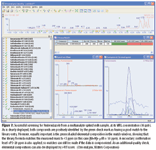
Figure 7
Table I shows a summary of the MRLs (where applicable), the level at which ChromaLynx screening gives a positive (tentative in brackets) identification, and the LoDs for each of the spiked compounds. All library entries are correctly identified at or below their MRL.
It is important to note that, while in this study a mass accuracy of <5 ppm has been considered confirmatory, there is currently no such consideration in EU legislation. A sample found to contain any of the analytes should therefore be subject to further analysis, typically on a tandem quadrupole–type MS-MS instrument, where product ion ratios are used for confirmation. Many groups are currently investigating and validating the use of accurate mass spectra for confirmatory purposes. However, at this early stage the authors recommend that two mass spectral peaks with <5 ppm accuracy, acquired with a mass resolution of at least 10,000 fwhm, should be considered for confirmation. Matching measured and theoretical isotope ratios has proven a reliable and conclusive method for the correct assignment of an analyte's identity and, hence, stringent criteria for this should be compulsory.

Table I: Analytesô MRL, screened concentration, and estimated LoD in milk
Conclusions
GC–TOF-MS and ultrahigh performance LC–TOF-MS represent powerful solutions for the rapid, comprehensive, and confident screening of compounds in complex biological matrices. In the cases shown here, it has been possible to apply a generic, minimal sample preparation procedure while achieving sensitivity beyond the required MRLs for veterinary drug residues and pesticides in food and feedstuffs as defined in European legislation (1,5). This is possible due to the full-spectrum sensitivity provided by oa-TOF instrumentation and can be extended to large numbers of residues without the loss in sensitivity that would be observed using quadrupole or ion trap instrumentation. The increased chromatographic resolution from ultrahigh performance LC separations also helps minimize matrix effects and obtain analyte peaks suitable for quantification in the oa-TOF analyzer. These quantitative results have been shown to correlate with levels observed from analysis on tandem quadrupole instruments.
Accurate mass measurement is a key metric for the successful screening of complex matrices. Its selectivity allows the analyst to confidently detect chromatographic peaks from complex mixtures in the presence of multiple coeluted compounds, while providing increases in S/N and limits of detection. Spectra with high mass accuracy and correct isotope ratios are also valuable aids for identifying contaminants, and might be appropriate for confirmatory analysis.
With the development of specialized software tools, it is now possible to automatically detect peaks, deconvolute mixtures, perform library searching, and carry out accurate mass confirmation in a routine manner from complex LC–MS or GC–MS datasets. This provides the analyst with the capability to confidently quantify and confirm compounds in a targeted environment, or quantify and identify unexpected compounds in an untargeted environment.
Acknowledgments
The authors would like to thank Hans van Rhijn from RIKILT Institute of Food Safety, Wageningen, The Netherlands, for both his collaboration in the veterinary drug residue analysis and his helpful comments in review of this article. We also thank Carmen Wauschkuhn, Diane Fuegel, and Michelangelo Anastassiades, CVUA Stuttgart, Fellbach 70736, Germany, for supplying sample extracts that were analyzed in the pesticide residue study.
Peter Hancock, Daniel McMillan, Jeff Goshawk, Kirsten Hobby, and Alistair Wallace are with Waters Corporation. E-mail: alistair_wallace@waters.com
References
(1) Regulation (EC) NO 396/2005 of 23 February 2005, Off. J. of the European Union No. L70/1.
(2) M. Anastassiades, S. Lehotay, D. Stajnbaher, and F. Schenck, J. AOAC Int. 86(2), 412 (2003).
(3) S.J. Lehotay, K. Mastovska, and S.J. Yun, J. AOAC Int. 88(2), 630 (2005).
(4) P. Hancock, Waters Application Note 720001607EN (www.waters.com) (2006).
(5) Recommendation of 18 January 2006, Off. J. of the European Union, No. L19/23.
(6) J.A. van Rhijn, C. Bourgeon, J.J.P. Lasaroms, E. Oosterink, and D. McMillan, Waters Application Note 720001675EN (www.waters.com) (2006).
(7) K. Hobby and R. Bateman, The Use of Isotope Ratio Measurements to Reduce the Number of Candidate Elemental Compositions from Accurate Mass Determination, Proceedings of the 54th ASMA Conference on Mass Spectrometry and Allied Topics, Seattle, WA, May 28–June 1, 2006. 112 TOA PM 03:40.
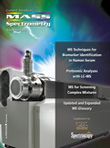
Analytical Challenges in Measuring Migration from Food Contact Materials
November 2nd 2015Food contact materials contain low molecular weight additives and processing aids which can migrate into foods leading to trace levels of contamination. Food safety is ensured through regulations, comprising compositional controls and migration limits, which present a significant analytical challenge to the food industry to ensure compliance and demonstrate due diligence. Of the various analytical approaches, LC-MS/MS has proved to be an essential tool in monitoring migration of target compounds into foods, and more sophisticated approaches such as LC-high resolution MS (Orbitrap) are being increasingly used for untargeted analysis to monitor non-intentionally added substances. This podcast will provide an overview to this area, illustrated with various applications showing current approaches being employed.
University of Rouen-Normandy Scientists Explore Eco-Friendly Sampling Approach for GC-HRMS
April 17th 2025Root exudates—substances secreted by living plant roots—are challenging to sample, as they are typically extracted using artificial devices and can vary widely in both quantity and composition across plant species.
Miniaturized GC–MS Method for BVOC Analysis of Spanish Trees
April 16th 2025University of Valladolid scientists used a miniaturized method for analyzing biogenic volatile organic compounds (BVOCs) emitted by tree species, using headspace solid-phase microextraction coupled with gas chromatography and quadrupole time-of-flight mass spectrometry (HS-SPME-GC–QTOF-MS) has been developed.
Common Challenges in Nitrosamine Analysis: An LCGC International Peer Exchange
April 15th 2025A recent roundtable discussion featuring Aloka Srinivasan of Raaha, Mayank Bhanti of the United States Pharmacopeia (USP), and Amber Burch of Purisys discussed the challenges surrounding nitrosamine analysis in pharmaceuticals.












